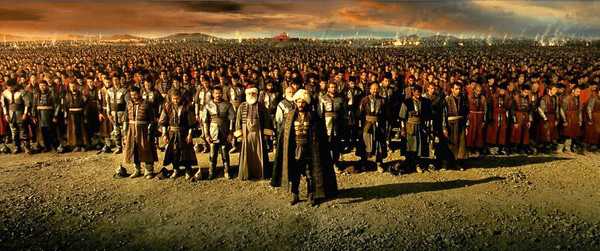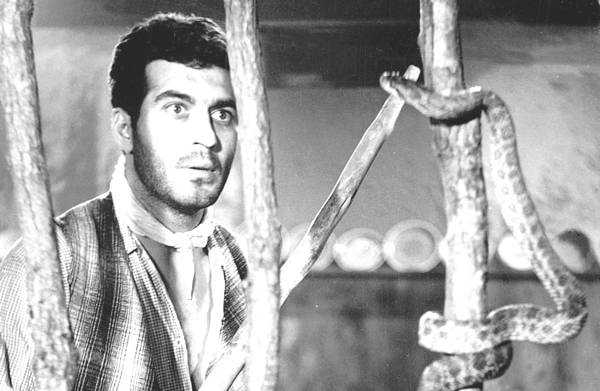The movie has been hugely successful in its home country since its premiere, telling of the Turks’ defeat of the Byzantine capital, but critics say it glosses over the sordid details.

| Mehmet II (Devrim Evin) leads thousands of soldiers to the gates of Constantinople in “Fetih 1453.” (Aksoy Film Productions, Aksoy Film Productions / January 26, 2012) |
By J. Michael Kennedy, Special to the Los Angeles TimesApril 28, 2012
ISTANBUL, Turkey — The Turks have a blockbuster on their hands. It’s called “Fetih 1453,” as in the year the Turks conquered the Byzantine capital of Constantinople — now the sprawling city of Istanbul. This epic, with 16,000 extras, sword fights, tons of blood and turbans galore, has broken all film records in Turkey, not only in how much it cost to make ($17 million) — but also the box office take, more than double the investment and counting.
Millions have seen the film since it opened in February — the premiere of which was an afternoon matinee that began at 14:53 p.m. in theaters around the country (the film opened Friday in Los Angeles). With his success, director Faruk Aksoy joins a growing list of successful Turkish moviemakers. Later this month, New York’s Lincoln Center will present a 29-film survey of Turkish films, influenced over the years by Egyptian, Indian and, more recently, Iranian cinema.
The movie’s timing seems prescient, since Turkey has a lot of nationalistic swagger in its step these days, what with its robust economic growth and emerging role as a political arbiter and strongman in the region. It’s cool these days to be a Turk.
So it’s no surprise that crowds have left the theaters chanting about Turkish patriotism, that Islamist Prime Minister Recep Tayyip Erdogan declared it “well done,” and that there have been a spate of articles talking about how the film harks back to a better time when the Ottomans ruled a great swath of the world.
The film, produced and directed by Aksoy, whose directing milieu heretofore had been comedy, tells of how the Ottomans’ 21-year-old ruler, Mehmet II, took down the walls of the already beleaguered city and put an end to the flagging Byzantine Empire. It’s filled with big battle scenes, the world’s largest cannon (forged by a woman, no less) and a cameo voice-over by an actor portraying the Prophet Mohammed.
Some critics have taken issue with the film, saying it glances over the more sordid details of the siege. But sitting in the posh office of his production company overlooking the Bosporus Strait, Aksoy said it’s no sin for a filmmaker to take historical license, something that’s been the stuff of celluloid since the silent era. “It’s a movie,” said Aksoy. “It’s not school, and it’s not a documentary. I’m not a teacher, I’m a director.”
Aksoy’s stance is understandable, given some of the brusque criticism that has come his way. The Greek weekly To Proto Thema complained that the “Turkish invaders are presented as the masters of the world. Faruk Aksoy fails to show important historical events such as looting and the mass slaughter of Greeks.”
Turkish columnist Burak Bekdil received a death threat after his caustic take on the film, in which he said that perhaps there should next be conquest films about the Armenian genocide of 1915 and the takeover of northern Cyprus in 1974. “Sadly,” he wrote, “millions of Turks will go to the theaters to feel proud of their ancestors and to visually show their children ‘our greatness.’ We are great not only because ‘we had the power of the sword’ but, even more sadly, because ‘we still adore the idea.’”
Even in the pro-government newspaper, Today’s Zamen, critic Emine Yildirim talked about the film’s “extreme nationalism” and said Turkish filmmakers should not make the same mistakes as Western moviemakers by dealing in stereotypes — in this case with the Byzantines portrayed as hedonistic dolts who loll about with gauzily clad women.
All of this makes Aksoy cringe. He said that nationalism is the wrong word for defining his movie. “It’s patriotism and all our nation is patriotic,” he said. “The Turkish nation has always complained that we have a glorious and rich history, but we haven’t shared it with the new generation here and the rest of the world.”
That seems only natural, since Turkey until recent years has had a major inferiority complex, descended from a vanished empire caught between Europe and the Middle East.
Aksoy said there is another reason the film wasn’t made earlier: Though he started thinking about the epic a dozen years ago, the Turkish film industry wasn’t prepared for a $17-million budget. “We didn’t have the financial capacity,” he said. “The last Turkish epic movie [“The Conquest of Constantinople”] was made in 1954,” he said.
“Fetih 1453” was filmed in several locations, using 3-D animation and on-location filming, including scenes in the northwestern city of Edirne, Mehmet II’s staging area for the siege of Constantinople.
On the eve of the film’s debut, Aksoy said he couldn’t sleep and couldn’t eat. One calculated risk was that he had no big-name Turkish actors in the movie, because he sensed stars would not be believable in the Ottoman setting. So he waited in a darkened theater to see the reaction of the audience to his movie, which was shot in 21 weeks over a three-year period. Then came the cheers and the throngs of viewers rushing to the theaters in Turkey, Europe and, in limited distribution, the United States.
Now he is playing the role of Turkey’s most successful filmmaker, one who is planning three more movies in the next five years — all of them historical. “I’m proud of that,” he said of his newfound fame.
https://www.latimes.com/entertainment/la-xpm-2012-apr-28-la-ca-culture-turkey-20120429-story.html




